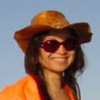Journal entries
Le Bon Journal
About
Search
Contact
Readers write
Show your support
Anne Ku writes about her travels, conversations, thoughts, events, music, and anything else that is interesting enough to fill a web page. She has written and produced two chamber operas, premiered in Utrecht, Netherlands. See her publication list for more.
Support the Bon Journal by keeping analyticalQ.com alive and free. Find out about Sponsorship or how else you can show your support
Bon Journal
New Music from China in Amsterdam
The sound of Chinese musical instruments accompanied my own upbringing in the context of Chinese history and culture. It was defined in black and white: Chinese or non-Chinese. Later as I embraced Western harmony and the chamber music tradition in Europe, I defined music as Western or non-Western.
Some five years ago, I first came across a new movement in Amsterdam of embedding non-Western instruments in Western ensembles. At first I thought it was bizarre to seek musicians from abroad to come to the Netherlands and perform their non-Western sounding instruments with a contemporary but very Western ensemble. Through the recitals and seminars organised by Joël Bons (artistic director of the Nieuw Ensemble -- which means, literally, the new ensemble) at the Amsterdam Conservatory, I gradually accepted the bold but innovative way to expand musical horizons. In this respect they are pushing the frontier of musical possibilities.
On Friday 22nd January 2010 in Amstelkerk, I sat in the front row eager to witness the premiere of works of four winners of a young Chinese composers' competition. It felt like an impromptu sneak preview on the night before the performers and composers were leaving for the Europalia festival in Gent, Belgium. In April, the highly regarded Amsterdam-based Nieuw Ensemble and four soloists from China will be touring China and Hong Kong with these works.
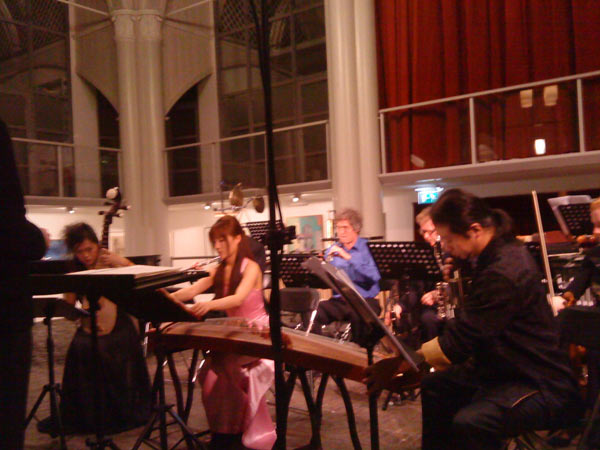
Conductor Garry Walker; Lan Weiwei (pipa), Ji Wei (zheng), Ernst Rombout (oboe), Wu Wei (sheng)
The concert began with the introduction of the four Chinese instruments. Three beautifully dressed young ladies and a man in a completely black outfit walked on stage. Each carried something not often seen in this part of the world.
Lan Weiwei introduced her pipa to the expectant audience. It looked like a lute but sounded much brighter and louder. She played an emotional folk piece from a Chinese story with her long (added/fake) fingernails. She was right when she said that you could hear the tears of the Chinese princess.
Next, Sun Huang played a sad melody on the erhu which sat on her lap but was bowed like a violin. She played as though her body and the instrument were fused as one ---- very sad and moving.
Lan Weiwei then introduced Chinese classical music on the zither, the zheng (also called gu zheng - ancient harp) Ji Wei's fingers danced on the strings --- a picturesque sight --- feminine, graceful, and refined.
Finally, Wu Wei stood up to play sheng, the Chinese mouth organ. Later I learned that they were four of the top musicians of Chinese instruments from China.
The programme was in Dutch and without links to web sites of composers. Hopefully they will find this review and let me link to their web sites. I've highlighted the names of the four winning composers in bold.
Programme:
Aftersound by Cheng Huihui (b. Heilong Jiang 1985)
BRAND II by Su Xiao (b. Nanjing 1983)
intermission
Vacuite/consistance (1996) by Xu Shuya (b. 1961) - premiered in 1997
Release by Liu Kun (b. Xi'an 1984)
Colour of Ink by Lan-chee Lam (b. Hong Kong 1982)
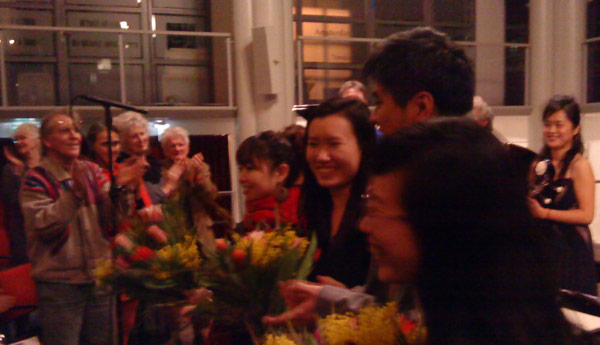
The four composers applauded by a standing ovation after the world premieres at Amstelkerk, Amsterdam
The first and the last piece made extensive use of "special" effects. At times, I felt as though everything was going on all at once. I scribbled on my notepad, "Something is always happening or about to happen." Sometimes the western instruments were played like Chinese, such as the guitar imitating the zither.
In the second piece, the zither was tuned in a non-standard way. After a big clap, the two percussionist jumped into action. Every instrument had its chance at being solo. It was an exciting tale told by different people, all engaging in the story.
The sheng player is smiling. The wind players are swinging with their heads and bodies. The cellist's eyes are wide open. The erhu player is shaking in a frenzy. The pipa and guitar play their ostinato in conversation with the rest. For a second, I thought I heard Yo Yo Ma playing a distant Chinese tragedy. The timpani sets the beat before a flute solo. Every instrument is distinctly heard, coming on and off stage for its turn. As clearly as the prelude preceded the main story, the reprise reminded us it's a lot of fun. The gong sounds and the bass clarinet has the final word. Suddenly it ends.
Before each piece, the ensemble and soloists changed their seating arrangement. It must be difficult for the conductor to adjust, I thought. I asked the main percussionist after the concert why it was necessary to change the seating. He replied that instruments could not all be heard otherwise. It made sense. In the third premiered piece "Release" the musicians sat in a linear or slightly curved row. What was interesting here was the deliberate tutti breathing in and out in unison, a reflection of references to Buddhism.
The cellist begins alone. Suddenly everyone takes a sharp but long breath. They breathe out. The cellist begins again. Tutti breathe in and out. The cello begins a third time. The viola plays a tremolo. The string players rub their strings frantically. The wind players blow air into their instruments. One aspect of contemporary music, I discovered, is about using your instrument in unconventional ways, making unexpected or unimaginable sounds. Even the conductor participates, joining the ensemble in chanting the omnipresent "OH" acapella to end the piece.
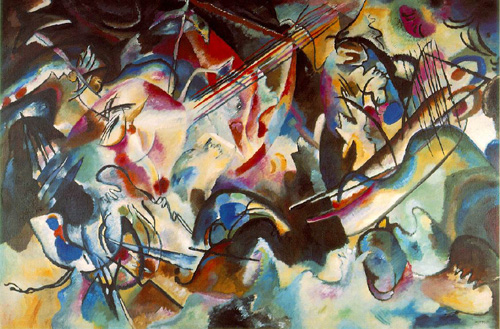
Composition VI by Wassily Kandinsky
The fourth premiere (and fifth piece in the concert) Colour of Ink was inspired by a painting of Kandinsky (above). I thought it was a piece about tension and restlessness. I wish I had read the programme notes before hearing the music, for it was beyond my imagination. The composition is a concerto grosso combining all four Chinese instruments with the ensemble to give new textures. Only afterwards did I notice the painting printed on the cover of the programme booklet. I shall have to ask the composer Lan Chee Lam about her work when I see her in person.
After the composers took their bows, I asked my concert companion, a musicologist turned composer, what he thought of the concert. "It was fantastic!" he said. "So many colours! Different textures! We can learn a lot from the Chinese."
How different it was from the views that my scholarly father had imparted on me in my youth. "There's nothing to learn about Chinese music," I recall him saying. "We have only five pitches. We are too primitive. We never developed like the way the West have. Western music is much more advanced."
Perhaps the East and the West have much more to offer to each other than their differences. The integration of non-Western instruments into Western ensembles and vice versa may become the norm, for the possibilities are seemingly endless and wondrously rich. While we, who grew up in Asia, have been learning and copying the West as though it was the only way to move forward and subconsciously forgetting our own kaleidoscope of colours and textures, the West has been looking East. Why was the West so fascinated by the East when so many of us deliberately chose a Western education, the way my father had chosen for us?
I am now only beginning to understand why. I want to hear tonight's music again.... and again....
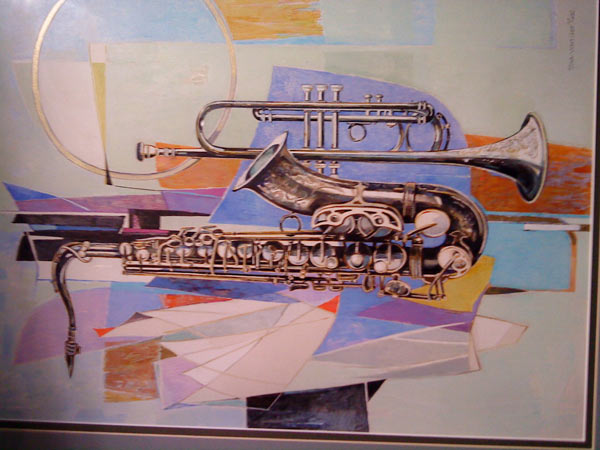
Painting by Isa van der Zee at Amstelkerk, Amsterdam
The first time I visited Amstelkerk was exactly 5 years ago, on the occasion of a book signing event . I was impressed by the central but quiet location of this renovated church in Amsterdam whose interior functions as office space, exhibition space, and the occasional concert hall. As I put on my winter coat to leave at 11 pm, I saw a painting from the current exhibition by Hilversum artist Isa van der Zee (above). How appropriately situated--- a painting of musical instruments!
25 January 2010
Related links:
Nieuw Ensemble
official web site
Amstelkerk, Amsterdam
Chime, European Foundation for Chinese Music Research
Europalia Festival
Belgium
Personal reviews
operas, concerts, competitions, festivals
Tan Dun's Marco Polo in Amsterdam
21 November 2008
Note:
I found out about the premiere concert of 22 January 2010 in Amstelkerk in four ways, but it didn't occur to me that I had time to attend the concert until 18th January!
- a facebook message in mid-December by the composer Lan Chee Lam that she was visiting Netherlands for the first time to hear a work of hers performed by the Nieuw Ensemble in mid-January
- an e-mail "Nieuw Ensemble Chinese Composers' Competition concert with Chime discount" on 14 January
- an e-mail announcement in Dutch by the Nieuw Ensemble on 18th January, and
- Amsterdam Conservatory news brief for composers on 19th January.
